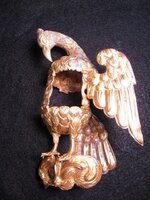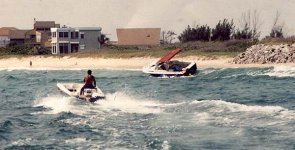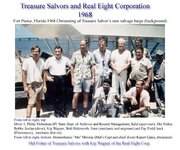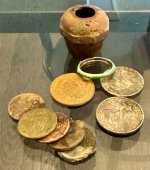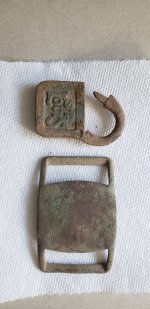I want to invest some money into a salvage effort of one of the treasure companies. But is there still alot of treasure to be found of the 1715 fleet or has it been over worked to death?? Would love to hear some of your comments to this subject as I will be leaving for Florida in week to seek opportunities. Thanks
You are using an out of date browser. It may not display this or other websites correctly.
You should upgrade or use an alternative browser.
You should upgrade or use an alternative browser.
Investing in the 1715 salvage efforts?? Is there much left to be found??
- Thread starter makahaman
- Start date
Au_Dreamers
Hero Member
According to Dr. R. Duncan Mathewson III, Archaeological Director of the search for the Nuestra Senora de Atocha there remains $700 million to $900 million in treasure left on the ocean bottom by the 1715 Treasure Fleet yet to be recovered.
I sent a pm about the operation I'm putting together
I sent a pm about the operation I'm putting together

signumops
Hero Member
- Feb 28, 2007
- 756
- 226
- Detector(s) used
- Garrett, Minelab, Aqua-Pulse
- Primary Interest:
- All Treasure Hunting
The easy pickings are gone. That would be the material that lies from average depths of 4 feet to 20 feet beneath the sea's surface. Figure a means of working in less than 4 feet of water in the active surf zone and you will be a rich individual... behold the Gold Digger, et al. Get some accurate excavation history information from Queens Jewels LLC and you might find some very significant stuff south of Sebastian Inlet. Devise the mother-of-all-digboats and you will probably find a fortune north of Sebastian Inlet.
This is an interesting question. Just for grins, I think I will do an acreage analysis on the leases.
This is an interesting question. Just for grins, I think I will do an acreage analysis on the leases.
Au_Dreamers
Hero Member
Attila said:Well my thoughts are:
Found in August 2010, value $885,000.
enough said
hehehe I was going to post that last night along with the following but got tired
or How about this....
http://www.wptv.com/dpp/news/region...rs-find-gold-off-coast-of-indian-river-county
The cannon was discovered in shallow waters – less than 15 feet deep – off of Sebastian, Florida, approximately 40 miles north of West Palm Beach. It was alongside 22 rare 2-Escudo gold coins. Only when the cannon was brought to the conservatory to preserve history was the remaining bounty discovered, 25 more of the valuable Spanish colonial gold coins inside and 38 silver coins, 4- and 8-Reales. The prize total was 85 coins.
UNCLENICK
Jr. Member
Where can you go on the internet to find that info? Plus what are some of the names of the companys? And what do you think of the book: Floridas Golden Galleons? I would like to purchase a book along these lines. Thank you for all the help! HH and safe diving.
Nick
Nick
UNCLENICK
Jr. Member
Also real quick...this is a stupid question, is it pronounced-es-coo-do? Thanks, hh and safe diving,
Nick
Nick
LM
Hero Member
signumops said:Figure a means of working in less than 4 feet of water in the active surf zone and you will be a rich individual...
Could you elaborate more on this, exactly what the challenges are for existing equiptment, etc?
mad4wrecks
Bronze Member
- Dec 20, 2004
- 2,263
- 107
- Detector(s) used
- Aquapulse, DetectorPro Headhunter, Fisher F75
- Primary Interest:
- Shipwrecks
LSMorgan picture this: You have managed to work your way inshore through the outer reefs and are now anchored in 4-6 feet of water. That is the surf zone. Even on calm days (rare), you still have waves breaking where your vessel is. Once you lower the blowers, you have maybe 2-3 feet of clearance. You run the chance of bottoming out the blowers or your running gear or ended up on the beach yourself as a shipwreck. You are so close to shore, you have to run your stern anchors up onto the beach. We used to use old tires and bury them on the beach using shovels. Of course by the end of the day we were "too tired" to dig the tires back up. You can't get away with that anymore. Once you finally manage to get a hole blown, you have to time it perfectly getting a diver over the berm and into and out of the hole. A wave comes in or the seas get choppy and now you have the boat bouncing up and down and someone could get crushed. Then there is the noise from working so close to shore. The homeowners and condo owners and beach goers aren't particularly fond of the noise.
As Terry mentioned, Danny Porter and Clay Courdary had some success on the Cabin wreck using a catamaran as a work platform. Weller used a jetboat inshore successfully once or twice until he swamped it.
It might be feasible to work from the beach using some type of dredge...if one could get permission.
There is still quite a bit of treasure left from the 1715 fleet. Think shallow and think deep and get away from the same areas that have been worked for 50 years.
Attached is a picture of Mo chasing down the Virgalona II (baby Virg) when she broke her bow anchor working close to shore off the McLarty.
Tom
As Terry mentioned, Danny Porter and Clay Courdary had some success on the Cabin wreck using a catamaran as a work platform. Weller used a jetboat inshore successfully once or twice until he swamped it.
It might be feasible to work from the beach using some type of dredge...if one could get permission.
There is still quite a bit of treasure left from the 1715 fleet. Think shallow and think deep and get away from the same areas that have been worked for 50 years.
Attached is a picture of Mo chasing down the Virgalona II (baby Virg) when she broke her bow anchor working close to shore off the McLarty.
Tom
Attachments
PyrateJim
Full Member
Tom, very true post. This is my favorite pic of "what can happen in a heartbeat". I remember that day well.
LM
Hero Member
mad4wrecks said:LSMorgan picture this: You have managed to work your way inshore through the outer reefs and are now anchored in 4-6 feet of water. That is the surf zone. Even on calm days (rare), you still have waves breaking where your vessel is. Once you lower the blowers, you have maybe 2-3 feet of clearance. You run the chance of bottoming out the blowers or your running gear or ended up on the beach yourself as a shipwreck. You are so close to shore, you have to run your stern anchors up onto the beach. We used to use old tires and bury them on the beach using shovels. Of course by the end of the day we were "too tired" to dig the tires back up. You can't get away with that anymore. Once you finally manage to get a hole blown, you have to time it perfectly getting a diver over the berm and into and out of the hole. A wave comes in or the seas get choppy and now you have the boat bouncing up and down and someone could get crushed. Then there is the noise from working so close to shore. The homeowners and condo owners and beach goers aren't particularly fond of the noise.
As Terry mentioned, Danny Porter and Clay Courdary had some success on the Cabin wreck using a catamaran as a work platform. Weller used a jetboat inshore successfully once or twice until he swamped it.
It might be feasible to work from the beach using some type of dredge...if one could get permission.
There is still quite a bit of treasure left from the 1715 fleet. Think shallow and think deep and get away from the same areas that have been worked for 50 years.
Attached is a picture of Mo chasing down the Virgalona II (baby Virg) when she broke her bow anchor working close to shore off the McLarty.
Tom
Awesome post. Now I kinda-sorta understand.
Thanks so much.
LM
Hero Member
I didn't bother drawing in the floats since the idea of a floating work deck isn't exactly novel and obviously, nothing is drawn to accurate scale... Just wanted to see if the concept was viable?
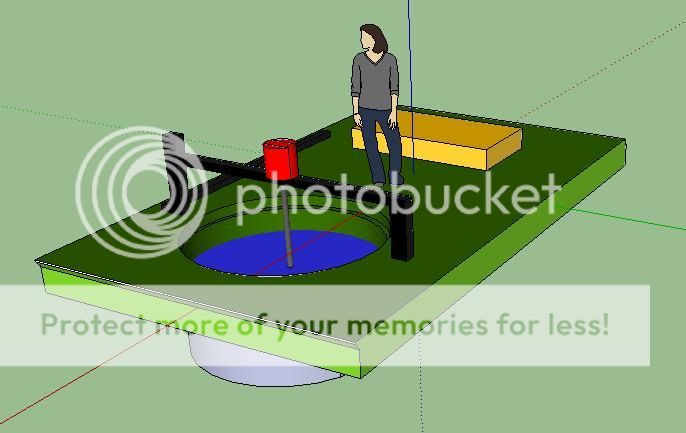
If you made a small, pontooned work deck, , arranged a battery bank towards the rear to power an overhead frame mounted (and decent sized) electric motor towards the front which turned a light turbine blade on an extended shaft that was immersed in the water, housed within a series of adjustable, progressive nesting cylinders that could be adjusted to optimal depth, couldn't this work?
It would be pretty stable and if smartly designed, light enough to maneuver with a push pole. If you wanted to get real clever, you could probably make the whole system light and modular enough to disassemble/reassemble into man portable components.
It could be anchored at four points. With the electric motor, it wouldn't be nearly as loud as a gas powered engine- damn near silent. One could use all standardized components to make it. If they make electric motors strong enough to move a EV converted Volkswagen @ 50 mph, they'll definitely be strong enough to generate some pretty significant force on a turbine blade. The only machining that would need to be done would probably be the shaft, some couplings and some gears, then just some basic math to figure out weight/buoyancy/displacement issues and whatever minor engineering math had to be done to account for operating forces. You'd have to waterproof some stuff, too. Intuitively, given what the components would probably cost, it probably wouldn't even be that expensive to make something like this.
Since the propulsion arrangement is directly overhead and unobstructed as opposed to deflected, you'd probably need much less aggregate energy to move the same amount of overburden that a prop wash would move- especially considering you'd be in really shallow water and imparting the force very close to the bottom anyway.
One couldn't take it out on a day with 6' groundswells and obviously, the rough sketch doesn't convey what would go into making the rig stable in a surf zone but on a relatively calm day, it would probably be more than stable enough to blow away some overburden.


If you made a small, pontooned work deck, , arranged a battery bank towards the rear to power an overhead frame mounted (and decent sized) electric motor towards the front which turned a light turbine blade on an extended shaft that was immersed in the water, housed within a series of adjustable, progressive nesting cylinders that could be adjusted to optimal depth, couldn't this work?
It would be pretty stable and if smartly designed, light enough to maneuver with a push pole. If you wanted to get real clever, you could probably make the whole system light and modular enough to disassemble/reassemble into man portable components.
It could be anchored at four points. With the electric motor, it wouldn't be nearly as loud as a gas powered engine- damn near silent. One could use all standardized components to make it. If they make electric motors strong enough to move a EV converted Volkswagen @ 50 mph, they'll definitely be strong enough to generate some pretty significant force on a turbine blade. The only machining that would need to be done would probably be the shaft, some couplings and some gears, then just some basic math to figure out weight/buoyancy/displacement issues and whatever minor engineering math had to be done to account for operating forces. You'd have to waterproof some stuff, too. Intuitively, given what the components would probably cost, it probably wouldn't even be that expensive to make something like this.
Since the propulsion arrangement is directly overhead and unobstructed as opposed to deflected, you'd probably need much less aggregate energy to move the same amount of overburden that a prop wash would move- especially considering you'd be in really shallow water and imparting the force very close to the bottom anyway.
One couldn't take it out on a day with 6' groundswells and obviously, the rough sketch doesn't convey what would go into making the rig stable in a surf zone but on a relatively calm day, it would probably be more than stable enough to blow away some overburden.

stevemc
Bronze Member
- Feb 12, 2005
- 2,121
- 277
- Detector(s) used
- Whites Surfmaster PI Pro and Whites Surfmaster PI, Minelab Excal NY blue sword. 2 White's Dual field pi, Garrett sea hunter pi II (but don't use it for obvious reasons) 5' x 3 1/2' coil underwater Pi
- Primary Interest:
- Shipwrecks
That is what was initially tried in the early days of Real Eight. They had a barge type boat, and a big prop, no tube, sticking straight down through a hole in the deck. Then they invented the mailbox, first called ash cans, because they looked like metal garbage cans. The thing was made to blow surface water which is usually clearer, especially during a rising tide, down to clear it all up below. But the good side effect was it blew the sand away. Bad things were it was hard to move, and when it blew, it caused a suction vortex on the surface. That is why the blower was made, doesnt have these problems, but hard to use in shallow water. Yes, something like this could work, but not the way you have it. First of all, you cant have the tube all the way to the surface. It would need a supply of water. And electric could be used, but it would really use up juice fast on batteries. Maybe a small enclosed marine type generator would work with a big enough motor.
LM
Hero Member
Maybe where the tube attaches towards the deck, there could be large ports for water to flow through to then be blown to the bottom?
It would be interesting to figure out what kind of balls are required in terms of how big the motor would have to be in order to blow meaningfully large holes. Obviously, something like this wouldn't be a replacement for the big stuff, but maybe an intermediate tool to do accomplish something more substantive than blowing with a DPV, yet still small and nimble enough to operate in the surf zone where the bigger boats have trouble.
You're definitely right that those big EV motors chow the shit out of battery charges... I guess that's why we still have gas stations
It would be interesting to figure out what kind of balls are required in terms of how big the motor would have to be in order to blow meaningfully large holes. Obviously, something like this wouldn't be a replacement for the big stuff, but maybe an intermediate tool to do accomplish something more substantive than blowing with a DPV, yet still small and nimble enough to operate in the surf zone where the bigger boats have trouble.
You're definitely right that those big EV motors chow the shit out of battery charges... I guess that's why we still have gas stations

VOC
Sr. Member
You can easy make scalled down versions of this with a steel tube, haudraulic motor and propellor and run it off a smaller power pack.
http://www.fisheroffshore.com/subsea-excavation.htm
Some have a T shape so the water flow comes in from each side rather than the top.
http://www.fisheroffshore.com/subsea-excavation.htm
Some have a T shape so the water flow comes in from each side rather than the top.
signumops
Hero Member
- Feb 28, 2007
- 756
- 226
- Detector(s) used
- Garrett, Minelab, Aqua-Pulse
- Primary Interest:
- All Treasure Hunting
Nick:
S coo dough
You can get plenty of books relating to the 1715 fleet from Alan Workman or Ernie Richards. I also have a few copies of my own book to sell.
LSMorgan:
Kudos on the model!
The attached pic is of the original Salvors/Real 8 kingpins in front of a barge built to work in the shallows. Old pic. The barge had airplane propellers underneath.
Personally, I think that divers, dressed in heavy canvas (urchins, rocks, crunchy coral), using hookah and equipped with small hydrolifts and metal detectors could probably find enough stuff to make the season worthwhile. These divers would have to use 40 or 50 pound weight belts and full face gear to stay in position. I tried this myself at Rio Mar using scuba and a jetski equipped with a deflector. Tough work if you can get it!
S coo dough
You can get plenty of books relating to the 1715 fleet from Alan Workman or Ernie Richards. I also have a few copies of my own book to sell.
LSMorgan:
Kudos on the model!
The attached pic is of the original Salvors/Real 8 kingpins in front of a barge built to work in the shallows. Old pic. The barge had airplane propellers underneath.
Personally, I think that divers, dressed in heavy canvas (urchins, rocks, crunchy coral), using hookah and equipped with small hydrolifts and metal detectors could probably find enough stuff to make the season worthwhile. These divers would have to use 40 or 50 pound weight belts and full face gear to stay in position. I tried this myself at Rio Mar using scuba and a jetski equipped with a deflector. Tough work if you can get it!
Attachments
mad4wrecks
Bronze Member
- Dec 20, 2004
- 2,263
- 107
- Detector(s) used
- Aquapulse, DetectorPro Headhunter, Fisher F75
- Primary Interest:
- Shipwrecks
yeah, just don't get caught on the reef at Rio Mar at low tide, when it is awash. I once had to crawl accross 100 ft of reef to get back to the beach and had sea urchin spines in my hands and knees for years after that! 

Hangingfor8
Hero Member
- Dec 16, 2007
- 513
- 54
- Detector(s) used
- Minelab and Aquapulse
- Primary Interest:
- Shipwrecks
Signumops has a great book called "The Rainbow Chasers" that I would recommend to anyone wanting to learn about the great Florida treasure hunting on the 1715 and the other wrecks around Florida.
UNCLENICK
Jr. Member
 Thank you Signumops! Very appriciated! hh safe diving
Thank you Signumops! Very appriciated! hh safe divingNick
Au_Dreamers
Hero Member
man I love your classic pictures!

Top Member Reactions
-
 2306
2306 -
 1113
1113 -
 1037
1037 -
 898
898 -
 837
837 -
 770
770 -
 756
756 -
 737
737 -
 606
606 -
 507
507 -
 492
492 -
 476
476 -
 447
447 -
 420
420 -
 398
398 -
O
398
-
 397
397 -
 394
394 -
 384
384 -
 376
376
Users who are viewing this thread
Total: 2 (members: 0, guests: 2)



